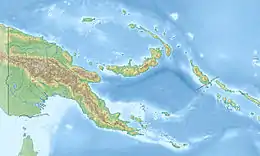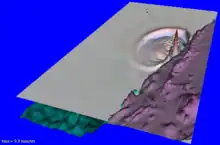 | |
| UTC time | 1998-07-17 08:49:13 |
|---|---|
| ISC event | 1167076 |
| USGS-ANSS | ComCat |
| Local date | July 17, 1998 |
| Local time | 6:49 pm |
| Duration | 19 seconds[1] |
| Magnitude | 7.0 Mw[2] |
| Depth | 30 km (19 mi)[2] |
| Epicenter | 3°07′S 142°26′E / 3.11°S 142.44°E[2] |
| Type | Dip-slip[1] |
| Areas affected | Papua New Guinea |
| Max. intensity | VIII (Severe)[3] |
| Tsunami | 15 m (49 ft)[4] |
| Casualties | 2,183–2,700 dead[4] Thousands injured[4] |
The 1998 Papua New Guinea earthquake occurred on July 17 with a moment magnitude of 7.0 and a maximum Mercalli intensity of VIII (Severe). The event occurred on a reverse fault near the north coast region of Papua New Guinea, 25 kilometers (16 mi) from the coast near Aitape, and caused a large undersea landslide which caused a tsunami that hit the coast, killing between at least 2,183 and 2,700 people and injuring thousands.
Tectonic setting
The island of New Guinea lies within the complex zone of collision between the Australian Plate and the Pacific Plate. Within this overall setting, the active tectonics of northern Papua New Guinea is dominate by the effects of continuing collision between the Huon–Finisterre island arc terrane with the edge of the Australian continental margin. The overall shortening is concentrated into two zones of thrust faulting, the Ramu–Markham fault zone, which forms the southwestern boundary of the Huon–Finisterre terrane, and the Highlands Thrust Belt, which lies further southwest and deforms the Australian margin.[5] The hanging wall of the Ramu–Markham thrust system is broken up by a series of strike-slip faults. The orientation of these faults, parallel to the direction of thrusting, suggests that they accommodate distortion of the Huon–Finisterre block. Most of the seismicity in northern Papua New Guinea is associated with the Ramu–Markham fault system, with a smaller number of earthquakes occurring on the strike-slip faults and on the Highlands Thrust Belt.
Earthquake
The earthquake occurred at 6:49pm local time (UTC+10) along the boundary of the Australian and the Pacific tectonic plates. The tsunami was originally thought to have been caused by a 2 m (6 ft 7 in) vertical drop in the Pacific Plate along a 25 mi (40 km) long fault.[6] Later work suggested that in fact a massive underwater landslide had occurred.[7]
The tsunami raised awareness among scientists of the potential for small earthquakes to trigger large tsunamis, if they cause undersea landslides. It is now recognised that such events can be very dangerous, as the earthquake may be too small to be felt on land, or detected by the Pacific Tsunami Warning Center. Any resulting tsunami can thus appear without warning.
Effects
The earthquake consisted of a main shock and several aftershocks that were felt in several towns in the area around the epicenter. The main shock caused some minor damage to the 62-year-old church at the Sissano Mission, and was strong enough that many people in Malol, Arop, and Warapu left their houses because the shaking lasted for so long. Cracks in the ground formed in Arop and Warapu.[8]

A few minutes after the earthquake, many residents reported hearing a loud clap as the tsunami approached the shoreline.[8] The tsunami resulted in at least 2,200 people being killed, thousands being injured, about 9,500 homeless and about 500 missing.[9] The maximum height of the waves was estimated at being 15 m (49 ft) high with an average height of 10.5 m (34 ft).[9][10]
The area worst hit was a 30 km (19 mi) coastal strip running north-west from Aitape to the village of Sissano. Several villages in the path of the tsunami were completely destroyed and others extensively damaged. The tsunami wave uprooted entire buildings and transported their foundations 50–60 metres (160–200 ft) from their original location [8] The village of Arop was situated on a narrow spit between the coast and Sissano Lagoon. It was directly in the path of the tsunami and was worst hit.
Response
Immediately after the tsunami the Royal Australian Air Force flew in three C-130 Hercules transport planes with relief supplies.[11] In the days following more relief was flown in and a field hospital was set up in the neighbouring town of Vanimo.[11] The amount of injury and illness due to the tsunami overwhelmed the makeshift hospitals, leaving many victims with wounds that were untreated for several days and led to gangrene.[12] Rotting dead bodies that remained in the lagoon spread diseases and the government sealed off the entire area. After the makeshift hospital in Vanimo was dismantled, the sick people became worse as the nearest hospital was over a day's walk away.
Several villages moved their buildings slightly further back from the sea when they eventually rebuilt.[13] Scientists from the University of Papua New Guinea initiated a public awareness program for the residents of the coastal area affected by the tsunami, to tell them that scientific models have concluded that the geology of the surrounding area causes the destructive waves to focus their energy on that area, making it a very dangerous place to live. The scientists also recommended that the Papua New Guinea government improve the escape routes for the villages and improve the tsunami warning system.[14] The country does not have a communications plan put in place, according to the UN Development Project's country report on Disaster Management.[15] According to the National Research institute, there are still no roads to the villages of Arop and Warapu. Also, the Sepik highway that connects to Aitape does not connect with the village of Vanimo.[16]
See also
References
- 1 2 Kikuchi, M.; Yamanaka, Y.; Abe, K.; Morita, Y. (1999), "Source rupture process of the Papua New Guinea earthquake of July 17, 1998 inferred from teleseismic body waves", Earth, Planets and Space, 51 (12): 1319, Bibcode:1999EP&S...51.1319K, doi:10.1186/bf03351605, S2CID 54643064
- 1 2 3 ISC (2015), ISC-GEM Global Instrumental Earthquake Catalogue (1900–2009), Version 2.0, International Seismological Centre
- ↑ USGS (December 1, 2008), EXPO-CAT Earthquake Catalog, Version 2007-12, United States Geological Survey
- 1 2 3 USGS (September 4, 2009), PAGER-CAT Earthquake Catalog, Version 2008_06.1, United States Geological Survey
- ↑ Abers, G.A.; McCaffrey, R. (1994). "Active arc-continent collision: Earthquakes, gravity anomalies, and fault kinematics in the Huon-Finisterre collision zone, Papua New Guinea". Tectonics. 13 (2): 227–245. Bibcode:1994Tecto..13..227A. doi:10.1029/93TC02940.
- ↑ AAP (July 23, 1998). "Plate shift left no warning time". The Age. p. 9.
- ↑ "Tsunamis threaten world's coastlines". CNN News. August 25, 1998. Retrieved April 18, 2007.
- 1 2 3 Davies, H. L.; Davies, J. M.; Perembo, R. C. B.; Lus, W. Y. (2003), "The Aitape 1998 Tsunami: Reconstructing the Event from Interviews and Field Mapping", Pure and Applied Geophysics, 160 (10): 1895–1922, Bibcode:2003PApGe.160.1895D, doi:10.1007/s00024-003-2413-1, S2CID 129431939
- 1 2 "Magnitude 7.1 Near North Coast of New Guinea, P.N.G. 1998 July 17 08:49:13 UTC". U.S. Geological Survey. Archived from the original on September 15, 2007. Retrieved April 18, 2007.
- ↑ "The Aitape PNG Earthquake/Tsunami". Geoscience Australia. Australian Government. Archived from the original on May 3, 2007. Retrieved April 2, 2007.
- 1 2 "Tidal wave kills 'thousands'". BBC News. July 20, 1998. Retrieved April 2, 2007.
- ↑ Sebastian's Story: Fighting to save Tsunami Survivors, CNN, July 23, 1998
- ↑ Tidal devastation: One year on BBC News July 16, 1999
- ↑ Learning from the Aitape Tsunami
- ↑ "Archived copy" (PDF). Archived from the original (PDF) on June 1, 2013. Retrieved May 8, 2015.
{{cite web}}: CS1 maint: archived copy as title (link) EMERGENCY & DISASTER MANAGEMENT AND DISASTER RISK REDUCTION IN PAPUA NEW GUINEA "National Disaster Center, Papua New Guinea" Retrieved December 20, 2013 - ↑ Sandaun Province "Cross Pillar Report" Archived November 3, 2013, at the Wayback Machine Retrieved December 20, 2013
Sources
- "Preliminary Analysis of Sedimentary Deposits from the 1998 Papua New Guinea (PNG) Tsunami". U.S. Geological Survey. Retrieved April 18, 2007.
- "Descriptive Model of the July 17, 1998 Papua New Guinea Tsunami". U.S. Geological Survey. Archived from the original on April 12, 2007. Retrieved April 18, 2007.
- International Tsunami Survey Team (September 1998). "Preliminary Report On The Tsunami Caused By Sissano Earthquake At, West Sepik, PNG On 17 July 1998". Archived from the original on September 1, 2020. Retrieved April 17, 2007.
- Synolakis, C. E.; Bardet, J-P; Borrero, J. C.; Davies, H. L.; Okal, E. A.; Silver, E. A.; Sweet, S.; Tappin, D. R. (2002). "The slump origin of the 1998 Papua New Guinea Tsunami". Proceedings of the Royal Society of London. Series A: Mathematical, Physical and Engineering Sciences. 458 (2020): 763–789. Bibcode:2002RSPSA.458..763S. doi:10.1098/rspa.2001.0915. ISSN 1364-5021. JSTOR 3067390. S2CID 128715334.
External links
- The Earthquake and Tsunami of 17 July 1998 in Papua-New Guinea (PNG) – George Pararas-Carayannis
- Albright brings news of more aid to wave-hit Papua New Guinea – CNN
- The International Seismological Centre has a bibliography and/or authoritative data for this event.